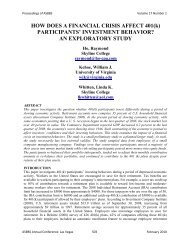stock repurchase announcements: a test of market ... - Asbbs.org
stock repurchase announcements: a test of market ... - Asbbs.org
stock repurchase announcements: a test of market ... - Asbbs.org
You also want an ePaper? Increase the reach of your titles
YUMPU automatically turns print PDFs into web optimized ePapers that Google loves.
Grady, Maniam and Leavell<br />
my brother, an 18 y ear-old male, could easily pose as a 26 y ear-old female with a lower risk <strong>of</strong><br />
detection, due to the anonymous nature <strong>of</strong> the Internet. However, if he were to attempt to use that<br />
identification in an actual face-to-face transaction, there is a great er possibility that he will get<br />
caught.<br />
Criminals have become more creative with methods used to commit identity theft. Web spo<strong>of</strong>ing<br />
and phishing are two results <strong>of</strong> these criminal’s creative thinking. Web spo<strong>of</strong>ing occurs when the<br />
criminal creates a bogus Web site that is sim ilar to a legitim ate site , to retrieve personal<br />
information from individuals who do n ot realize th e site is a sham . The FBI named spo<strong>of</strong>ing to<br />
be the bigge st cause <strong>of</strong> t he rise in identit y th eft a nd ot her frauds committed on t he Int ernet<br />
(Dinev, 2006).<br />
Responses to phishing attacks account for 20 percent <strong>of</strong> online methods <strong>of</strong> identity theft (Mercuri,<br />
2006). Phishing occurs when em ail messages that appear to be legitimate are sent, in bulk, t o<br />
Internet users. These e mails usually contain info rmation that appears to be i mportant regarding<br />
their user accounts, such as “there are problema tic activities,” in an attempt to scare the user<br />
enough to respond t o the message (Dinev, 2 006, p. 81). The re cipient becomes distressed and<br />
visits the site, revealing identit y inf ormation, and does not tho roughly inve stigate the site to<br />
ensure its authenticity.<br />
FINANCIAL IMPACT OF IDENTITY THEFT<br />
Consumers, businesses, and governments are all victims <strong>of</strong> identity theft. Consumers suffer from<br />
the im pact <strong>of</strong> identit y thef t, both em otionally and fi nancially, as their reputation and finan cial<br />
standing are injured. Businesses and governm ents suffer greater financial loss than consumers<br />
due to the costs incurred t o restore the damage from identity theft and costs for taking measures<br />
to prevent i dentity theft. A survey conducte d by t he FTC in 2003 claim s t hat businesses and<br />
financial institutions have lost at least $47 b illion, while the tot al am ount spent by indi vidual<br />
victims is about $5 billion yearly in identity theft related costs (Newman, 2004).<br />
Consumers are the ultimate victims <strong>of</strong> identity theft due to the severity <strong>of</strong> the damage caused by<br />
the crime. T hese identity theft victi ms suffer little financial loss compared to t heir business and<br />
government counterparts, but they do suffer from a disruption <strong>of</strong> t heir lives and the hindrance in<br />
the ability to obtain further credit. Victims have experienced pain and suffering from banks, debt<br />
collectors, and even law enforcement due to identity theft (Newman, 2004).<br />
There are tw o measures <strong>of</strong> identity theft for cons umers: time and dollars spent resear ching and<br />
defending their cases. It i s estimated that identity theft has cost Americans at least five bil lion<br />
dollars. Also, victims have claimed to have spent, on average, 600 hours and $1400 in an attempt<br />
to correct their credit (White, 2005). These are just the averages; there is evidence that there are<br />
some individuals who have spent in excess <strong>of</strong> 10,000 hours and $30,000 to clear the damage from<br />
identity theft.<br />
The burden <strong>of</strong> pro<strong>of</strong> is the responsibility <strong>of</strong> the vi ctim, meaning that all the costs associat ed with<br />
proving their innocence are paid for out-<strong>of</strong>-poc ket. These out-<strong>of</strong>-pocket costs might include<br />
travel expenses, police reports, and certified mail, t o name a f ew (Identity T heft, 2003) . The<br />
amount <strong>of</strong> c osts incurred have been anywhere fr om as low as $4 to $ 30,000 and hi gher,<br />
depending on the severity <strong>of</strong> the crime. The costs could be recovered if the thief is caught and<br />
sentenced, but the likelihood that the thief has the money for retribution is very low, resulting in<br />
total loss for some victims.<br />
ASBBS E-Journal, Volume 4, No.1, 2008 49

















